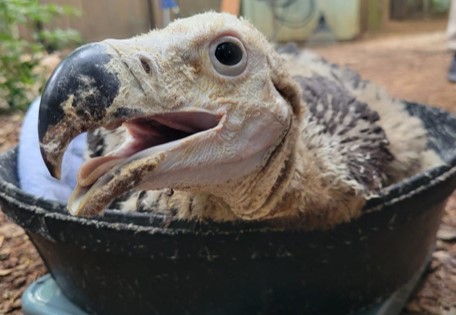Summary of Hatching Seti – Zoo Atlanta:
Claire S., a bird keeper, reports that zoo guests often marvel at the lappet-faced vulture pair, Amana and Anubis, on the main path, but may not notice Seti, a young vulture, nesting out of sight. Seti was hatched on May 22 in an incubator and initially hand-raised with a puppet at the Avian Propagation Center for health and safety reasons. She was later reintroduced to her parents, who have since been diligently caring for her. Now three months old, Seti is growing well and practicing for eventual flight, expected to leave the nest by late September. Visitors might glimpse her through the shed window.
- The successful hatching and rearing of Seti, the lappet-faced vulture at Zoo Atlanta.
- The vital role of the Bird Care Team in ensuring Seti’s health and survival.
- The behaviors and characteristics of lappet-faced vultures, particularly concerning their care and parenting.
- The conservation significance of breeding endangered species like the lappet-faced vulture.
- The broader implications of avian propagation programs in global wildlife conservation efforts.
The successful hatching and rearing of Seti, a lappet-faced vulture chick at Zoo Atlanta, represents a significant achievement in avian conservation. Lappet-faced vultures are the largest vulture species in Africa, boasting wingspans of eight to nine feet. Their size and striking appearance make them a standout species in the zoo.
Seti arrived on May 22, hatched in an incubator under the watchful eyes of the Bird Care Team. The team played a crucial role in her early development, relocating her to the Avian Propagation Center for the initial ten days. At the center, they used a vulture puppet for hand-raising to prevent human imprinting—a technique critical for the chick’s future survival and integration with its species. This period ensured that Seti was healthy, responsive to feeding, and physically resilient.
Once robust enough, Seti was introduced back to her parents, Amana and Anubis. This reintroduction was not just a simple family reunion. It required careful observation and monitoring, as the Bird Care Team needed to confirm the parents’ acceptance and proper care of the chick. To their delight, Anubis quickly began tending to Seti, ensuring she was warm and feeding her adequately. This initial acceptance is often the most tenuous part of reintroduction, but crucial for the chick’s development.
Lappet-faced vultures, like Seti, are fascinating not just because of their size, but due to their behavior and parental care. Typically, these vultures lay one to two eggs per breeding season, and caring for the young is a shared responsibility. Amana and Anubis exemplified this, taking turns in feeding and brooding Seti. As Seti grew, the parents allowed her more independence, indicative of her readiness to explore the wider world outside the nest. Now three months old, Seti spends her days eating, resting, and practicing wing flapping, essential for her eventual flights.
Monitoring Seti’s progress underscores the intricate balance and challenges in avian conservation. The initial hand-raising phase ensured her survival during her most vulnerable period. This method, though labor-intensive, resulted in a healthier and more resilient chick. The careful management practices at Zoo Atlanta highlight the importance of human intervention in wildlife conservation, particularly in cases involving endangered species like the lappet-faced vulture.
The conservation work at Zoo Atlanta, as demonstrated by Seti’s story, is vital in the broader context of global efforts to preserve endangered species. Lappet-faced vultures are currently facing numerous threats, including habitat loss, poisonings, and reductions in food availability. Successful breeding programs in zoos not only help maintain the population but also provide critical data on the species’ biology and behavior. These programs offer a safety net against extinction, serving as a genetic reservoir for future reintroductions to the wild.
Moreover, avian propagation programs like those at Zoo Atlanta play a significant role in educating the public about the importance of wildlife conservation. By witnessing the growth and development of Seti, visitors gain insight into the complexities and rewards of conservation work. The presence of these magnificent birds raises awareness and fosters a deeper connection between the public and wildlife, promoting a culture of conservation and stewardship.
The successful rearing of Seti also highlights the collaborative nature of conservation efforts, involving veterinarians, zookeepers, and conservation scientists. This multidisciplinary approach ensures a comprehensive strategy in maintaining the health and genetic diversity of endangered species. Each team member brings specialized knowledge, whether in avian medicine, behavioral studies, or habitat management, all contributing to the broader goal of species preservation.
In conclusion, Seti’s journey from incubator to fledging vulture is a testament to the meticulous and dedicated efforts of the Bird Care Team at Zoo Atlanta. Her story underscores the critical importance of conservation programs in zoos, not only for the survival of individual animals but for the preservation of entire species. By continuing to support and develop these programs, we make significant strides toward ensuring the survival of endangered species like the lappet-faced vulture, securing their place in our world’s biodiversity for future generations to witness and appreciate.


